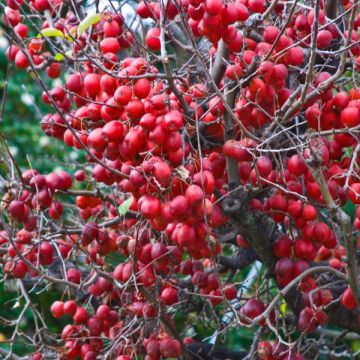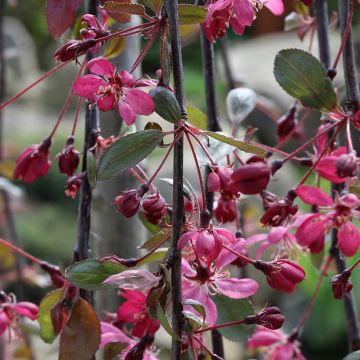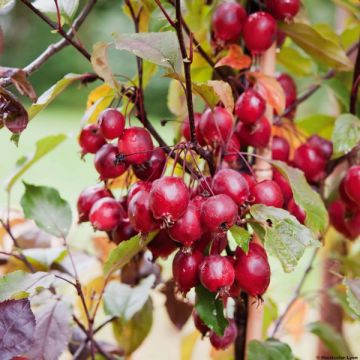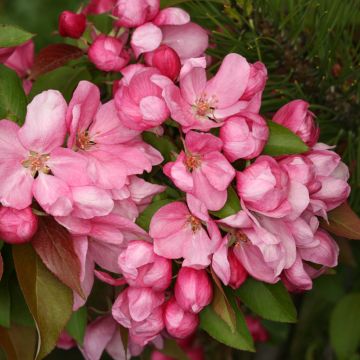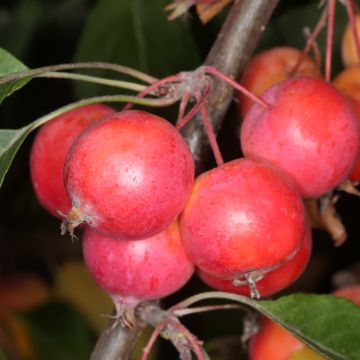

Malus robusta Yellow Siberian - Crab Apple


Malus robusta Yellow Siberian - Crab Apple
Malus robusta Yellow Siberian - Crab Apple
Malus robusta Yellow Siberian
Siberian Crab Apple
Special offer!
Receive a €20 voucher for any order over €90 (excluding delivery costs, credit notes, and plastic-free options)!
1- Add your favorite plants to your cart.
2- Once you have reached €90, confirm your order (you can even choose the delivery date!).
3- As soon as your order is shipped, you will receive an email containing your voucher code, valid for 3 months (90 days).
Your voucher is unique and can only be used once, for any order with a minimum value of €20, excluding delivery costs.
Can be combined with other current offers, non-divisible and non-refundable.
Why not try an alternative variety in stock?
View all →This plant carries a 24 months recovery warranty
More information
We guarantee the quality of our plants for a full growing cycle, and will replace at our expense any plant that fails to recover under normal climatic and planting conditions.
Would this plant suit my garden?
Set up your Plantfit profile →
Description
Malus x robusta 'Yellow Siberian' is a variety of ornamental apple tree full of advantages and decorative for a large part of the year. In spring, pretty pink buds produce pure white single flowers, much appreciated by bees. They are well highlighted by the dark green foliage. In late summer, a multitude of decorative yellow fruits appear and last until winter, delighting birds during this difficult time. This variety is not susceptible to diseases. Very hardy, this apple tree adapts to the majority of soils that are not too dry. It is still a little-known variety that deserves to be planted more, especially since it is very easy to grow.
Ornamental apple trees originate from various botanical species of the Malus genus. They belong to the Rosaceae family, like most of our fruit trees (pear, plum, apricot, peach) and many ornamental plants. Hardy, adaptable, and easy to grow, flowering apple trees are satisfied with ordinary soil, but prefer loamy, deep, loose, and moist soil, as well as sunny exposures. Once established, they can tolerate neglect while maintaining their generous nature. Numerous cultivars have been developed in Europe, as well as in the United States, becoming increasingly attractive and resistant to diseases.
'Yellow Siberian' is an ancient variety, imported from Siberia around 1920 by Niels Ebbesen Hansen, an American-Danish horticulturist and botanist. This enthusiast conducted explorations in the harsh climates of northern Scandinavia, Siberia, and Manchuria in search of plants acclimatisable to the United States. Malus x robusta is a hybrid resulting from the cross-breeding between Malus baccata (originating from Russia, Mongolia, China, Korea) and Malus prunifolia from China. Malus x robusta forms an extremely hardy, fairly large tree, 12m (39ft) tall and 10m (33ft) wide.
The 'Yellow Siberian' variety has a much more limited growth, reaching a maximum height of 4 or 5m (13 or 16ft), with a width of 3 to 4m (10 to 13ft), making it a great choice for small gardens. This small tree has a slightly disordered habit in the early years. It eventually forms a rounded crown. It has inherited a great resistance to cold, down to approximately -34°C (-29.2°F), as well as good resistance to diseases that spare its dark green foliage. In April, it is adorned with floral buds of a lovely pink colour that open into pure white single flowers, until May. These flowers, with their romantic charm and light fragrance, gathered in small bouquets, stand out well against the rather dark mass of foliage. They are nectar-producing, and are popular with bees. The flowering is followed by the formation of a multitude of relatively large apples, with a beautiful golden yellow colour. These fruits are much appreciated by birds, and remain attached to the plant for a good part of winter.
Like many flowering apple trees, Malus 'Yellow Siberian' is a good pollinator for fruit-bearing apple trees. Decorative both with its flowers and fruits for several months of the year, it is an excellent choice for a small garden. It can be planted alone on a lawn, in a flower bed alongside other ornamental plants, and even in a rural hedge, where its natural appearance allows it to blend in and where it will be appreciated by wildlife. To create a decorative flower bed for winter, plant it with other plants with decorative fruits such as the European Spindle Tree, Euonymus europaeus, with orange and pink fruits (toxic!) in the shape of "bishop's hats", and with a slightly wild appearance. Snowberries with their white, pink, or purplish berries, depending on the variety, will be good companions under the branches of this Siberian apple tree.
Malus robusta Yellow Siberian - Crab Apple in pictures






Plant habit
Flowering
Foliage
Botanical data
Malus
robusta
Yellow Siberian
Rosaceae
Siberian Crab Apple
Cultivar or hybrid
Other Malus - Crabapple
View all →Planting and care
Easy to grow in ordinary soil, 'Yellow Siberian' requires a sunny exposure. Ornamental malus trees are generally very accommodating, but they like fertile, deep, not too dry soils. After careful planting and installation accompanied by regular watering during the first two years, they can take care of themselves. Plant it in the sun in fairly rich, moist but well-drained soil, giving it enough space to spread. Dig a large planting hole. If the soil is poor, add compost to the planting soil and apply fertiliser or compost at its base every spring. Pruning is not obligatory, but you can prune lightly to regularise or shape the tree after flowering, avoiding cutting thick branches.
Planting period
Intended location
Care
Planting & care advice
This item has not been reviewed yet - be the first to leave a review about it.
Haven't found what you were looking for?
Hardiness is the lowest winter temperature a plant can endure without suffering serious damage or even dying. However, hardiness is affected by location (a sheltered area, such as a patio), protection (winter cover) and soil type (hardiness is improved by well-drained soil).

Photo Sharing Terms & Conditions
In order to encourage gardeners to interact and share their experiences, Promesse de fleurs offers various media enabling content to be uploaded onto its Site - in particular via the ‘Photo sharing’ module.
The User agrees to refrain from:
- Posting any content that is illegal, prejudicial, insulting, racist, inciteful to hatred, revisionist, contrary to public decency, that infringes on privacy or on the privacy rights of third parties, in particular the publicity rights of persons and goods, intellectual property rights, or the right to privacy.
- Submitting content on behalf of a third party;
- Impersonate the identity of a third party and/or publish any personal information about a third party;
In general, the User undertakes to refrain from any unethical behaviour.
All Content (in particular text, comments, files, images, photos, videos, creative works, etc.), which may be subject to property or intellectual property rights, image or other private rights, shall remain the property of the User, subject to the limited rights granted by the terms of the licence granted by Promesse de fleurs as stated below. Users are at liberty to publish or not to publish such Content on the Site, notably via the ‘Photo Sharing’ facility, and accept that this Content shall be made public and freely accessible, notably on the Internet.
Users further acknowledge, undertake to have ,and guarantee that they hold all necessary rights and permissions to publish such material on the Site, in particular with regard to the legislation in force pertaining to any privacy, property, intellectual property, image, or contractual rights, or rights of any other nature. By publishing such Content on the Site, Users acknowledge accepting full liability as publishers of the Content within the meaning of the law, and grant Promesse de fleurs, free of charge, an inclusive, worldwide licence for the said Content for the entire duration of its publication, including all reproduction, representation, up/downloading, displaying, performing, transmission, and storage rights.
Users also grant permission for their name to be linked to the Content and accept that this link may not always be made available.
By engaging in posting material, Users consent to their Content becoming automatically accessible on the Internet, in particular on other sites and/or blogs and/or web pages of the Promesse de fleurs site, including in particular social pages and the Promesse de fleurs catalogue.
Users may secure the removal of entrusted content free of charge by issuing a simple request via our contact form.
The flowering period indicated on our website applies to countries and regions located in USDA zone 8 (France, the United Kingdom, Ireland, the Netherlands, etc.)
It will vary according to where you live:
- In zones 9 to 10 (Italy, Spain, Greece, etc.), flowering will occur about 2 to 4 weeks earlier.
- In zones 6 to 7 (Germany, Poland, Slovenia, and lower mountainous regions), flowering will be delayed by 2 to 3 weeks.
- In zone 5 (Central Europe, Scandinavia), blooming will be delayed by 3 to 5 weeks.
In temperate climates, pruning of spring-flowering shrubs (forsythia, spireas, etc.) should be done just after flowering.
Pruning of summer-flowering shrubs (Indian Lilac, Perovskia, etc.) can be done in winter or spring.
In cold regions as well as with frost-sensitive plants, avoid pruning too early when severe frosts may still occur.
The planting period indicated on our website applies to countries and regions located in USDA zone 8 (France, United Kingdom, Ireland, Netherlands).
It will vary according to where you live:
- In Mediterranean zones (Marseille, Madrid, Milan, etc.), autumn and winter are the best planting periods.
- In continental zones (Strasbourg, Munich, Vienna, etc.), delay planting by 2 to 3 weeks in spring and bring it forward by 2 to 4 weeks in autumn.
- In mountainous regions (the Alps, Pyrenees, Carpathians, etc.), it is best to plant in late spring (May-June) or late summer (August-September).
The harvesting period indicated on our website applies to countries and regions in USDA zone 8 (France, England, Ireland, the Netherlands).
In colder areas (Scandinavia, Poland, Austria...) fruit and vegetable harvests are likely to be delayed by 3-4 weeks.
In warmer areas (Italy, Spain, Greece, etc.), harvesting will probably take place earlier, depending on weather conditions.
The sowing periods indicated on our website apply to countries and regions within USDA Zone 8 (France, UK, Ireland, Netherlands).
In colder areas (Scandinavia, Poland, Austria...), delay any outdoor sowing by 3-4 weeks, or sow under glass.
In warmer climes (Italy, Spain, Greece, etc.), bring outdoor sowing forward by a few weeks.

































